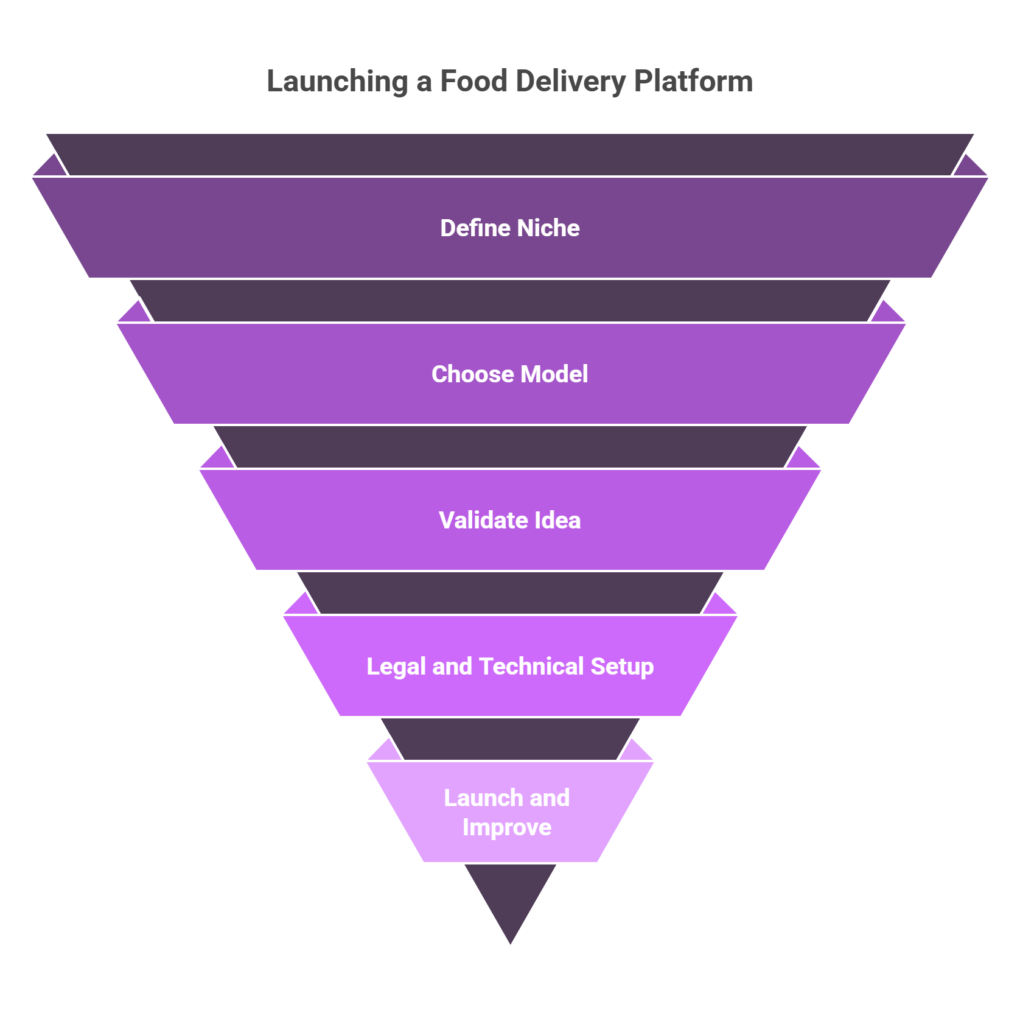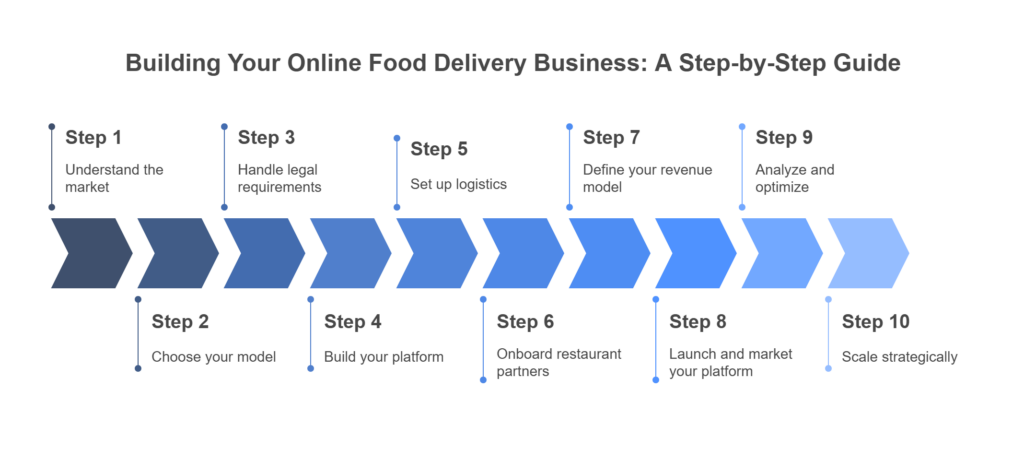Hey there, future food-tech founder.
If you’ve ever scrolled through a food delivery app at midnight and thought, “I could totally build something like this,” you’re not alone—and you might be onto something.
With the global online food delivery market projected to surpass $500 billion by 2025, and consumer habits permanently reshaped after the pandemic, this industry is hotter than ever. But turning your idea into a successful business takes more than a slick app and a list of partner restaurants.
In this guide, we’ll cover:
- how to start an online food delivery business plan from scratch
- the latest trends and statistics shaping the food delivery industry in 2025
- a step-by-step roadmap to go from idea to execution
Let’s dive in.
How to start an online food delivery business
If you’re serious about launching a food delivery platform in 2025, here’s a streamlined overview of the process. A strong online food delivery business plan should address each of these phases in detail.

1. Define your niche
Are you targeting late-night eaters, vegan meals, healthy lunchboxes, or hyperlocal restaurants? Focusing on a niche helps reduce early competition and build a loyal customer base. This is a foundational step in your online food delivery business plan.
2. Choose your business model
Common models include:
- order-only platform
- order and delivery service
- cloud kitchen or dark kitchen
Each option affects your operations, investment needs, and tech requirements. Make sure your online food delivery business plan clearly outlines the pros, cons, and logistics of your chosen model.
3. Validate your idea
Before investing in app development:
- talk to restaurant owners
- survey potential customers
- launch a basic landing page to gauge interest
Idea validation should be a key milestone in your online food delivery business plan to reduce risk and confirm market demand.
4. Take care of legal and technical setup
- register your business officially
- apply for food safety and logistics licenses
- begin building your minimum viable product (MVP)
These initial tasks are essential and should be documented in your online food delivery business plan under startup essentials.
5. Launch, test, and improve
Start with a small user group. Collect feedback, observe what works, and refine your platform. This iterative approach should be built into your strategy from day one.
Food delivery trends and statistics for 2025
Staying informed about industry shifts is key to making future-ready decisions.
Key statistics:
- the global market is expected to grow at a 12% CAGR through 2025
- over 70% of Gen Z and millennials order food online at least once per week
- 40% of users prefer ordering directly from restaurants
- personalized recommendations boost conversion rates by up to 30%
- eco-conscious packaging is influencing more buying decisions
Trends to watch:
- faster hyperlocal deliveries
- expansion of ghost kitchens
- AI-powered personalized menus
- integration with voice assistants and chatbots
- subscription models for loyalty and predictability
- eco-friendly, branded packaging
Including these trends in your online food delivery business plan will help position your startup as innovative and competitive.
A step-by-step food delivery startup roadmap

Let’s walk through how to build your business from the ground up.
Step 1: Understand the market
Research your local food delivery landscape:
- which platforms dominate?
- what are users unhappy with?
- where are the gaps in cuisine, pricing, or service?
Your findings should inform your positioning strategy, which must be part of your online food delivery business plan.
Step 2: Choose your model
Decide between:
- an order-only platform
- a hybrid model with delivery logistics
- a cloud kitchen model
This decision impacts your tech stack, operations, and revenue potential. Make sure your plan explains the reasoning behind your choice.
Step 3: Handle legal requirements
- register your business (e.g., LLC or Pvt Ltd)
- apply for relevant licenses and permits
- create contracts for vendors and delivery partners
A solid legal framework is essential and should be clearly outlined in your online food delivery business plan.
Step 4: Build your platform
Your platform should include:
For customers:
- easy registration
- real-time order tracking
- secure payment options
- filters, ratings, and reviews
For restaurants:
- menu and order management tools
- performance dashboards
- sales and analytics features
Start with an MVP and scale gradually. Include feature priorities and development phases in your online food delivery business plan.
Step 5: Set up logistics
If you’re managing deliveries:
- recruit or contract a driver fleet
- use GPS tracking and route optimization
- train and incentivize drivers
Reliable logistics are vital to customer satisfaction and repeat orders. These should be detailed in your operational plan.
Step 6: Onboard restaurant partners
Start with 20–30 popular or niche local restaurants.
Offer easy onboarding, transparent commission structures, and marketing support. This step helps establish credibility early on.
Step 7: Define your revenue model
Your income sources may include:
- commissions from restaurants
- delivery fees
- premium subscriptions
- featured listings
- dynamic pricing during peak times
Choose a pricing strategy that offers value to all parties and include detailed financial projections in your online food delivery business plan.
Step 8: Launch and market your platform
Use a mix of marketing strategies:
- social media and influencer partnerships
- referral and loyalty programs
- flyers in apartments or offices
- branded delivery bags and promotions
Focus your initial marketing on a small, well-targeted area to build traction quickly.
Step 9: Analyze and optimize
Track key metrics:
- order volume
- average delivery times
- user retention and satisfaction
Use tools like Google Analytics or Firebase to optimize user experience. Make data-driven refinement a recurring part of your roadmap.
Step 10: Scale strategically
After achieving product-market fit:
- expand to new regions
- onboard more restaurants
- offer additional services like catering or groceries
- consider cloud kitchens for operational control
Scale what’s working and stay laser-focused on customer experience.
Final thoughts
Starting an online food delivery business in 2025 offers both massive opportunities and complex challenges. With a well-defined niche, an effective operational model, awareness of key industry trends, and a carefully developed online food delivery business plan, you’ll be equipped to launch and grow successfully.
You’ve got the vision—now it’s time to execute. Contact us if you need assistance with developing an online food delivery platform.
